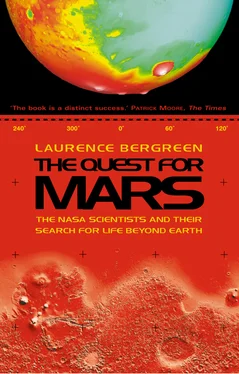1 ...6 7 8 10 11 12 ...25 During Jim’s early career at the agency, an unofficial Mars Underground developed within NASA’s bureaucracy. This was a loosely-knit affiliation of scientists and engineers who maintained a keen interest in Mars, despite the agency’s lack of Mars programs, and who also maintained a fervent desire to return to the Red Planet, first with robotic spacecraft, and later, with people, if the money and the motivation could somehow be found. The Mars Underground published papers, held symposia, and tended the flame through difficult times.
These were not easy years for Jim. An instrument he’d proposed, a radar altimeter, was initially selected for a Mars mission, but later deselected, or dropped. Soon after, in January 1986, the Space Shuttle Challenger disaster threw the agency into crisis. A period of soul-searching ensued within NASA. He worked for Sally Ride, the astronaut, on a project designed to renew the agency. Out of copious discussions, the Ride committee produced a grand new vision for NASA: the United States must return to the moon, and, beyond that, establish a permanent lunar base. Their recommendations were never acted on. After the group disbanded, Jim’s laser altimeter was selected for the Mars Observer mission, which ended in catastrophe in September 1993.
Finally, in 1996, Mars’s time came round again. First, there was NASA’s announcement of the discovery of nano-fossils in a meteorite from Mars. Suddenly, as one scientist put it, NASA was bitten by the life-on-Mars bug. The discovery, by a team of NASA scientists, gave the agency a focus it had been lacking since the Challenger disaster a decade earlier. The following year, the Pathfinder spacecraft settled on Mars on the Fourth of July, and its miniature rover rolled down a ramp and inched across the surface of the Red Planet, acting as a robotic geologist. “We can now get to the Red Planet for the price of a big-budget Hollywood movie,” NASA claimed. Jim puts it even more simply: “ Mars is back .” It’s his mantra.
The Keflavik Naval Air Station, where Jim and I are billeted in Iceland, is a sprawling NATO base that once served as an essential Cold War outpost. These days, it’s mostly a stopover for young European pilots who bring their planes in from France or Italy; they drink a lot, sleep a little, and depart at first light. Although Jim is a civil servant, his quasi-military status becomes evident the moment he enters the base. He salutes everybody , and they salute back – at least, some do. “My civil service status grade is equivalent to a Colonel’s,” he says, “but no one here is aware of that.”
We’re assigned to the Bachelor Officers Quarters, cement barracks strongly reminiscent of college dormitories. The penetrating odor of burned pizza crust wafts through the halls; the walls reverberate with blasts of heavy metal music. Occasionally, you hear squeals and shouts from girls who may or may not belong here. When you look out the window, you see a landscape so flat and featureless it could be Nebraska. There are schools, playgrounds, pickup trucks, a movie theater, a bowling alley, and a Wendy’s where they play “God Bless America,” country-style, over the PA system. The unofficial motto of the base might be: “Keflavik, a Nice Place to Raise a Family.”
In July, it’s light all the time, and the only way you can tell it’s late in Keflavik is that it gets very quiet. For a few hours, there are no cars zipping around the roads, no fighter jets streaking overhead. Around midnight, there’s a sort of dusk, a suggestion of darkness like a shadow across the sky, but it soon passes, and brightness returns by 2 AM or so.
A few days after our Surtsey expedition, Jim goes forth in search of glaciers to measure. We head out in a Land Rover Discovery across the treeless, craggy, doom-laden landscape, in which people, or, for that matter, all life forms, even grass, seem out of place. Mars on Earth. “You have to remember, Iceland, except in the highlands, looks like the ocean floor,” Jim says. “Now, what if I were Spock in ‘Star Trek,’ looking at the Earth from the Starship Enterprise? Captain Kirk says, ‘Spock, what do you see? Put the scanners on.’ I’d say, ‘I see a watery planet. It’s a planet dominated by oceans.’ The land is an insignificant fraction of what makes up this planet. If we could peel away the water and look at the Earth from space, planetary scientists would say, ‘I see what the Earth does. It has a large system of very thin crustal blocks that are moving and being eaten up in some places and being regenerated in others.’”
Jim catches his breath and swerves to avoid a small herd of scrawny Icelandic sheep. “Now we are starting to add a tapestry of new measurements from Mars Global Surveyor, as we try to understand all these different surface units on Mars. Scientists want to find hot pits, if there are any, just like the ones you saw on Surtsey. Now, how big were they on Surtsey?”
Just a few inches wide, I remind him, and he points out that it would be very difficult to see such tiny formations from space, even at high resolution. “You would need an extremely sensitive thermal scanner in orbit.” Such a device actually exists, but it would not, on its own, be able to detect alien life. Scientists also look for biomarkers, that is, distinctive signatures of life. And they seek signs of an energy or nutrient system capable of sustaining life. “On Mars, we want to find playas, dried up sea-beds, where there might have been standing bodies of water. We see playas on Earth, in the dried lake beds of the western United States, the dry lakes of Australia. On Mars, these playas may be even bigger. The topography measured by the laser going around Mars can find those areas for us.” So playas may hold clues to life on Mars, and volcanoes may also lead scientists to Martian gardens of Eden. It may just be Garvin’s bias, because he is crater expert, but he thinks volcanoes are an important component in the design for living – another reason that Iceland appeals to him. “Iceland has volcanoes that are active, with ice, certainly something that happened on Mars. We have volcanoes interacting with ground water, very important, because there may be ground water on Mars. We don’t know. And we have volcanoes here producing new lava at great rates. Some of the volcanoes on Mars have sustained high eruption rates for hundreds or even thousands of years. That’s what it takes to make an Olympus Mons” – and Olympus Mons is so big that it couldn’t exist on Earth. “There’s too much gravity here, and anything aspiring to Olympus Mons-like grandeur would collapse under its own weight.” He likens its shape to the much smaller lava shield volcanoes of Iceland. The term is meant to suggest a Viking shield turned on its side; a lava shield volcano slopes very gently. “It’s the most common landform made by volcanism in the Solar System. Mother Nature does not know how to do it any simpler.”
Later, we coast past an immense, dry lake bed studded with pebbles. We get out and walk across its dusty surface. It would not be surprising to see a pterodactyl soar overhead, or a spacecraft descend from the skies. This is Nature’s rough draft, a land of possibilities. It’s not as polished as later versions, but the crude landscape yields its secrets and intentions to geologists. “When the water dries up, it leaves behind a lag deposit of rocks,” Jim remarks. The rocks range in size from small cobbles up to large boulders. “And anything bigger,” he announces, “is called a real big boulder! The bright stuff you see here is a layer of desiccated, cemented dust made of clay. That is what comes out of suspension when water evaporates. We expect to see signatures of that kind of stuff on Mars.” He points to a fissure in the soil. “See this desiccation crack? This is what we hope to see on Mars.”
Читать дальше












